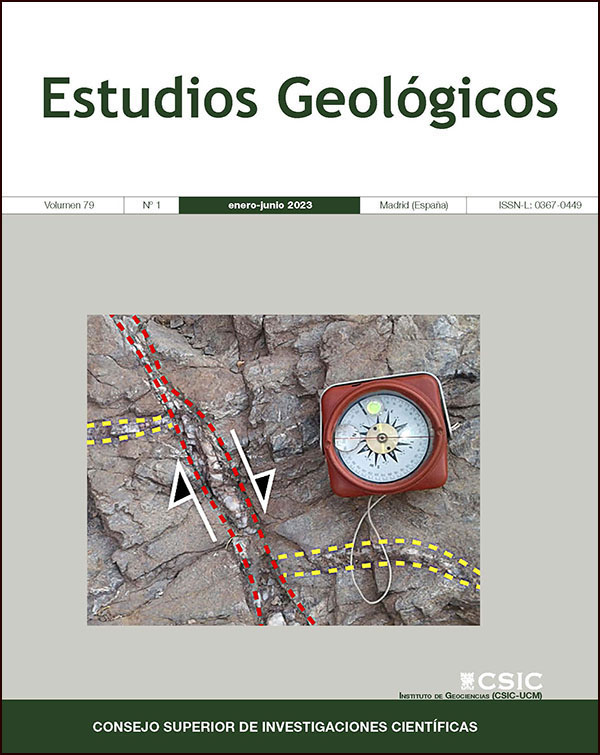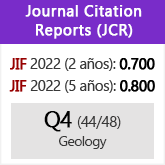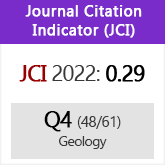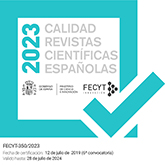Reinvestigación de los ocres de antimonio históricos de cervantitas-tipo
DOI:
https://doi.org/10.3989/egeol.44775.621Palabras clave:
Cervantita, Romeita, Hydroxycalcioromeita, Especimen-tipo, Raman, XPSResumen
Los ocres de antimonio son óxi-hidróxidos formados por meteorización de estibnita (Sb2S3). Normalmente aparecen como fases minerales simples cristalizadas en el sistema cúbico con estructura de tipo pirocloro y conteniendo algo de calcio y moléculas de agua en su red cristalina. Sus rangos composicionales pueden ser expresados por la fórmula: Sb5+ 2-x (Sb3+, Ca)y (O, OH, H2O)6-7, donde (y) está cerca de 1 y (x) va de 0 a 1. También es muy frecuente que los ocres de antimonio incluyan sustituciones de As, Fe, Ta, Ti, Cu y otros. Esta variabilidad química dentro de la misma estructura ha generado confusiones históricas de nombres de minerales equivalentes con patrones de difracción de rayos X muy similares siendo importante complementar con técnicas analíticas adicionales. El mineral-tipo cervantita de Cervantes (Lugo, España) (Ca, Sb3+)2(Sb5+)2O6(OH) fue desacreditado en 1954 y re-aprobado en 1962 como α-cervantita Sb3+Sb5+O4 difractando muestras de óxidos de antimonio sintéticos y naturales de otras localidades, como por ejemplo de Brasina (Serbia). En este trabajo estudiamos ambos minerales-tipo de Cervantes (Lugo, Spain) y de Zajaca-Stolice (Brasina, Serbia) desde los puntos de vista estructural, químico-elemental, termal, vibracional y de especiación química, asumiendo que los patrones de difracción de rayos X, los de la estructura tipo pirocloro son muy similares entre ellos. El espécimen tipo de Cervantes (Lugo) puede ser considerado como hydroxycalcioromeita (Ca,Sb3+)2(Sb5+)2O6(OH) mientras que el de Brasina Ca2(Sb5+)4O12(OH)2 es muy similar pero sin Sb3+. Ambas muestras contienen calcio y componentes hidratados, es decir, ambos están lejos de ser la α-Cervantita (Sb3+Sb5+O4) oficial anhidra y ortorrómbica. La espectroscopia micro-Raman es esencial para determinar fases minerales y vibraciones de enlaces Sb-O, mientras que espectroscopia FTIR y los ATD-TG fueron útiles para determinar grupos hidroxilos y aguas moleculares y la espectroscopia XPS para definir las especiaciones químicas del antimonio.
Descargas
Citas
Abdel-Galil E.A.; El-Kenany W.M. & Hussin L.M.S. (2015). Preparation of nanostructured hydrated antimony oxide using a sol-gel process. Characterization and applications for sorption of La3+ and Sm3+ from aqueous solutions. Russian Journal of Applied Chemistry, 88(8): 1351-1360. https://doi.org/10.1134/S1070427215080200
Adelman, J.G.; Beauchemin, S.; Hendershot, W.H. & Kwong, Y.T.J. (2012). Change in the oxidation rate of stibnite as affected by pyrite in an oxygenated flow-through system. Geochemistry: Exploration, Environment, Analysis, 12: 227-239. https://doi.org/10.1144/1467-7873/11-RA-077
Ambe, S. (1987). Adsorption kinetics of antimony (V) ions onto α-Fe2O3 surfaces from an aqueous solution. Langmuir, 3(4): 489-493. https://doi.org/10.1021/la00076a009
Atencio D.; Andrade, M.B.; Christy, A.G.; Gieré, R. & Kartashow, P.M. (2010). The pyrochlore supergroup of minerals: nomenclature. Canadian Mineralogist, 48: 673-698. https://doi.org/10.3749/canmin.48.3.673
Báez, D.F.; Pardo H.; Laborda I.; Marco J.F.; Yáñez C. & Bollo S. (2017). Reduced graphene oxides: Influence of the reduction method on the electrocatalytic effect towards nucleic acid oxidation. Nanomaterials, 7 (7): 168. https://doi.org/10.3390/nano7070168 PMid:28677654 PMCid:PMC5535234
Bahfenne S. & Frost R.L. (2010). Raman spectroscopic study of the antimonate mineral lewisite (Ca, Fe, Na)2(Sb,Ti)2O6(O, OH)7. Radiation Effects and Defects in Solids, 165 (1): 46-53. https://doi.org/10.1080/10420150903418485
Bahfenne S. & Frost R.L. (2010). Vibrational Spectroscopic Study of the Antimonate Mineral Stibiconite. Spectroscopy Letters, 43 (6): 486-490. https://doi.org/10.1080/00387010903360313
Bahfenne S. & Frost R.L. (2010) Raman spectroscopic study of the antimonate mineral romeite. Spectrochimica Acta, Part A: Molecular and Biomolecular Spectroscopy, 75 (2): 637-639. https://doi.org/10.1016/j.saa.2009.11.031 PMid:20034848
Beudant F.S. (1837). Traité élémentaire de Minéralogie, 2nd edition, Carilian Jeune, Paris.
Biagioni C.; Orlandi P.; Nestola F. & Bianchin S. (2013). Oxycalcioroméite, Ca2Sb2O6O, from Buca della Vena mine, Apuan Alps, Tuscany, Italy: a new member of the pyrochlore supergroup. Mineralogical Magazine, 77 (7): 3027-3037. https://doi.org/10.1180/minmag.2013.077.7.12
Birchall T.; Connor J.A. & Hillier I (1975). High-energy photoelectron spectroscopy of some antimony compounds. Journal of the Chemical Society, Dalton Transactions, 20: 2003-2006. https://doi.org/10.1039/dt9750002003
Bodenes L.; A. Darwiche, L. Monconduit & Martinez H. (2015).The Solid Electrolyte Interphase a key parameter of the high performance of Sb in sodium-ion batteries: Comparative x-ray photoelectron spectroscopy study of Sb/Na-ion and Sb/Li-ion batteries. Journal of Power Sources, 273: 14-24. https://doi.org/10.1016/j.jpowsour.2014.09.037
Botto, L.; Schalamuk, I.; Ametrano, S. & De Barrio, R. (1990). The vibrational spectrum of Cervantite (α-Sb2O4). Anales de la Asociación Química Argentina, 78 (4): 195-201.
Burke, E.A.J. (2006) A mass discreditation of GQN minerals. Canadian Mineralogist, 44: 1557-1560. https://doi.org/10.2113/gscanmin.44.6.1557
Cody C.A.; L. Dicarlo & Darlington R.K. (1979). Vibrational and Thermal Study of Antimony Oxides. Inorganic Chemistry, 18 (6): 1572-1576. https://doi.org/10.1021/ic50196a036
Corby Anderson G. (2019). SME Mineral Processing and Extractive Metallurgy Handbook. Society for Mining, Metallurgy and Exploration, USA, 2203 pp.
Damour A. (1841). Sur la roméite, nouvelle espèce minérale, de St. Marcel, Piemont. Annales des Mines, 20 (3): 247-254. https://rruff.info/uploads/Annales_des_mines_20_1841_247.pdf
Dana J.D. (1850). A system of mineralogy: Comprising the most recent discoveries, 3rd edition. George P. Putnam, New York, London, 711 pp.
Delobel R.; H. Baussart & Leroy J.M. (1983). X-ray photoelectron spectroscopy study of uranium and antimony mixed metal-oxide catalysts. Journal of the Chemical Society, Faraday Transactions, 79: 879-891. https://doi.org/10.1039/f19837900879
Gadsden J.A. (1975). Infrared spectra of minerals and related inorganic compounds. Buttherworth & CO, London, 277 pp.
Garbassi F. (1980). XPS and AES Study of Antimony Oxides. Surface and interface analysis, 5(2): 165-169. https://doi.org/10.1002/sia.740020502
Garcia-Guinea J.; Garrido F.; López-Arce P.; Correcher V. & Delafiguera J. (2017). Spectral green cathodoluminescence emission from surfaces of insulators with metal-hydroxyl bonds. Journal of Luminescence, 190: 128-135. https://doi.org/10.1016/j.jlumin.2017.05.039
Garcia-Guinea J.; Correcher V.; Can N.; Garrido F. & Townsend P.D. (2018). Cathodoluminescence spectra recorded from surfaces of solids with hydrous molecules. Journal of Electron Spectroscopy and Related Phenomena, 227: 1-8. https://doi.org/10.1016/j.elspec.2018.05.008
Gilliam S.J.; Jensen J.O.; Banerjee A.; Zeroka D.; Kirkby S.J. & Merrow C.N. (2004). A theoretical and experimental study of Sb4O6: vibrational analysis, infrared and Raman spectra. Spectrochimica Acta Part A: Molecular Spectroscopy, 60: 425-434 https://doi.org/10.1016/S1386-1425(03)00245-2 PMid:14670509
Gottlieb P.; Wilkie G.; Sutherland D.; Ho-Tun E.; Suthers S.; Perera K.; Jenkins B.; Spencer S.; Butcher A. & Rayner J. (2000). Using quantitative electron microscopy for process mineralogy applications. The Journal of the Minerals, Metals and Materials Society, 52: 24-25 https://doi.org/10.1007/s11837-000-0126-9
Gründer W.; Pätzold H. & Strunz H. (1962). Sb2O4 als Mineral (Cervantit). Neues Jahrbuch für Mineralogie / Monatshefte, 5: 93-98.
Gunasekaran S, G. Anbalagan, G. & Pandi S. (2006). Raman and infrared spectra of carbonates of calcite structure. Journal of the Raman Spectroscopy, 37: 892-899 https://doi.org/10.1002/jrs.1518
Hussak E. & Prior G.T. (2018) Lewisite and zirkelite, two new Brazilian minerals. Mineralogical Magazine, 11: 80-88. https://doi.org/10.1180/minmag.1895.011.50.05
Izquierdo R.; Sacher E. & Yelon A. (1989). X-ray photoelectron spectra of antimony oxides. Applied Surface Science, 40: 175-177. https://doi.org/10.1016/0169-4332(89)90173-6
Kharbish S. & Jelen S. (2016). Raman spectroscopy of the Pb-Sb sulfosalts minerals: Boulangerite, jamesonite, robinsonite and zinkenite. Vibrational Spectroscopy, 85: 157-166. https://doi.org/10.1016/j.vibspec.2016.04.016
Li N.; Xia Y.; Mao Z.; Wang L.; Guan Y. & Zheng A. (2012) Influence of antimony oxide on flammability of polypropylene/intumescent flame retardant system. Polymer Degradation and Stability, 97(9): 1737-1744. https://doi.org/10.1016/j.polymdegradstab.2012.06.011
López G.P.; Castuer D.G. & Ratner B. (1991). XPS O1s binding energies for polymers containing hydroxyl, ether, ketone and ester groups. Surface and Interface Analysis, 17: 267-272. https://doi.org/10.1002/sia.740170508
Makreski P.; G. Petrusevski, S. Ugarkovic & G. Jovanovski (2013) Laser-induced transformation of stibnite (Sb2S3) and other structurally related salts. Vibrational Spectroscopy 68: 177-182. https://doi.org/10.1016/j.vibspec.2013.07.007
Marco J.F.; Gancedo J.R.; Ortiz J. & Gautier J.L. (2004). Characterization of the spinel-related oxides NixCO3−xO4 (x=0.3,1.3,1.8) prepared by spray pyrolysis at 350°C. Applied Surface Science, 227: 175-186. https://doi.org/10.1016/j.apsusc.2003.11.065
Meškinis S.; Vasiliauskas A.; Andrulevičius M.; Peckus D.; Tamulevičius S. & Viskontas K. (2020). Diamond like carbon films containing Si: Structure and nonlinear optical properties. Materials, 13 (4): 1-15. https://doi.org/10.3390/ma13041003 PMid:32102249 PMCid:PMC7079637
Martín, J.D. (2006). XPowder: Programa para análisis cualitativo y cuantitativo por difracción de rayos X. Macla, 4: 35-44.
Miller, P.J. & Cody C.A. (1982). Infrared and Raman investigation of vitreous antimony trioxide. Spectrochimica Acta Part A: Molecular Spectroscopy, 38(5): 555-559 https://doi.org/10.1016/0584-8539(82)80146-3
Morgan W.E.; Stec, W.J. & Van Wazer J.R. (1973). Inner-orbital binding-energy shifts of antimony and bismuth compounds. Inorganic Chemistry, 12(4): 953-955. https://doi.org/10.1021/ic50122a054
Moulder J.F.; Stickle W.F.; Sobol P.E. & Bomben K.D. (1992) Handbook of X-ray Photoelectron Spectroscopy. Perkin-Elmer, Eden Prairie, USA, 261 pp.
Vitaliano C.J. & Mason B. (1952). Stibiconite and Cervantite. American Mineralogist, 37: 982-999. http://www.minsocam.org/ammin/AM37/AM37_982.pdf
Multani R.S.; Feldmann T. & Demopoulos G.P. (2016). Antimony in the metallurgical industry: A review of its chemistry and environmental stabilization options. Hydrometallurgy 164: 141-153. https://doi.org/10.1016/j.hydromet.2016.06.014
Orecchio S. (2013) Micro-analytical characterization of decorations in handmade ancient floor tiles using inductively coupled plasma optical emission spectrometry (ICP-OES). Microchemical Journal, 108: 137-150. https://doi.org/10.1016/j.microc.2012.10.011
Rouse R.C.; Dunn P.J.; Peacor Dr. & Wang L. (1998), Structural studies of the natural antimonian pyrochlores. I. Mixed valency, cation site splitting, and symmetry reduction in lewisite. Journal of Solid State Chemistry, 141: 562-569. https://doi.org/10.1006/jssc.1998.8019
Schaller W.T. (1916). Mineralogical notes. Schneebergite and Romeite. U.S. Geological Survey Bulletin, 610: 81-95 https://pubs.usgs.gov/bul/0610/report.pdf
Fleischer M (1962). New mineral names. American Mineralogist, 47(9-10): 1216-1223.
Siebert H. (1959). Infrared spectra of telluric acids, tellurates and antimonates. Zeitschrift für anorganische und Allgemeine Chemie, 301: 161-170. https://doi.org/10.1002/zaac.19593010305
Smirnov M.Y.; A.V. Kalinkin & V.I. Bukhtiyarov (2007). X-ray photoelectron spectroscopic study of the interaction of supported metal catalysts with NOx. Journal of Structural Chemistry, 48: 1053-1060 https://doi.org/10.1007/s10947-007-0170-1
Stevens J.G.; Etter R.M. & Setzer E.W. (1993). 121Sb Mössbauer spectroscopic study of the mineral stibiconite. Nuclear Instruments and Methods in Physics Research B, 76: 252-253. https://doi.org/10.1016/0168-583X(93)95199-F
Stevens-Kalceff M.A. & Phillips M.R. (1995). Cathodoluminescence micro-characterization of the defect structure of quartz. Physical Review B., 52: 3122-3134 https://doi.org/10.1103/PhysRevB.52.3122 PMid:9981428
Wagner C.D.; Naumkin A.V.; Kraut-Vass A.; Allison J.W.; Powell C.J. & Rumble J.R. Jr. (2003) NIST Standard Reference Database 20, Version 3.4, web version. http:/srdata.nist.gov/xps/
Wilson S.C.; P.V. Lockwood, P.M. Ashley &Tighe M. (2010). The chemistry and behavior of antimony in the soil environment with comparisons to arsenic: A critical review. Environmental Pollution, 158 (5): 1169-1181, https://doi.org/10.1016/j.envpol.2009.10.045 PMid:19914753
Zubkova V.; D.Y. Pushcharowsky, D. Atencio, A.V. Arakcheeva & P.A. Matioli. (2000) The crystal structure of lewisite, (Ca,Sb3+,Fe3+,Al,Na,Mn)2(Sb5+,Ti)2O6(OH). Journal of Alloys and Compounds, 296: 75-79. https://doi.org/10.1016/S0925-8388(99)00513-7
Publicado
Cómo citar
Número
Sección
Licencia
Derechos de autor 2023 Consejo Superior de Investigaciones Científicas (CSIC)

Esta obra está bajo una licencia internacional Creative Commons Atribución 4.0.
© CSIC. Los originales publicados en las ediciones impresa y electrónica de esta Revista son propiedad del Consejo Superior de Investigaciones Científicas, siendo necesario citar la procedencia en cualquier reproducción parcial o total.Salvo indicación contraria, todos los contenidos de la edición electrónica se distribuyen bajo una licencia de uso y distribución “Creative Commons Reconocimiento 4.0 Internacional ” (CC BY 4.0). Puede consultar desde aquí la versión informativa y el texto legal de la licencia. Esta circunstancia ha de hacerse constar expresamente de esta forma cuando sea necesario.
No se autoriza el depósito en repositorios, páginas web personales o similares de cualquier otra versión distinta a la publicada por el editor.
Datos de los fondos
Ministerio de Ciencia e Innovación
Números de la subvención PID2019-105469RB-C22

















